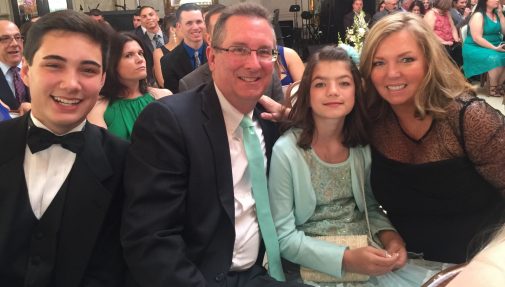
My sudden cardiac arrest survival story: Part three

If you missed part two of my story, click here to read about what happened after a team of paramedics arrived at my home when I went into cardiac arrest.
At the end of my last blog, the Advocate Good Shepherd Hospital cardiac team asked the question, “How do we help prevent Tom from having another cardiac arrest?” The answer is: an ICD to help regulate my heart’s rhythms for the rest of my life.
An ICD is an implantable cardioverter defibrillator. The ICD is used to treat ventricular arrhythmias, like I have. The ICD has wires with electrodes that connect to two of my heart’s chambers. These wires carry the electrical signals from my heart to a small computer in the ICD. The computer monitors my heart’s rhythm, and there is also a pulse generator and a battery powers the device. My doctors tell me that the battery should last 10 years.
This intelligent technology also records all of my heart’s electrical activity and heart rhythms and sends that information to my electrophysiologist every night for his review and analysis. The information is sent from a 8.5 by 5 wireless transmission device (made by Boston Scientific) which is on the nightstand next to my bed.
The ICD is above my heart and below my collar bone. It is easily visible, and you can clearly see its shape and touch it (you won’t get shocked, and it has no effect on me if you touch it). I am certainly aware it is there, but it doesn’t hurt at all. In fact, it is about the size of a deck of playing cards.
My lovely wife Noreen has named it “Little Buddy.”
In addition to the ICD, my doctors have me taking metroprol, a beta blocker which helps to treat my arrhythmias. Metoprolol slows down the heart by relaxing blood vessels, which improves blood flow and lowers my blood pressure. A lower heart rate is a benefit for patients like me who have an irregular heartbeat, especially if those beats may be too fast or quiver.
In May, I had an echocardiogram, which is a test in which sound waves are used to produce images of the heart and the blood pumping through the heart. This test is used to measure a heart’s ejection fraction (EF). The EF is a measurement of the percentage of blood leaving the heart each time it contracts. An EF fraction of 55 percent or higher is considered normal. My latest reading is 45-50 percent, which is an improvement from a previous reading of 40-45 percent. I need to continue to exercise regularly and watch my salt intake to help improve that fraction.
On July 3, I celebrated my 57th birthday, a day that I would have never experienced had I not been blessed with quick-thinking kids, a quick and responsive police and fire department and the great doctors and nurses at Advocate Good Shepherd Hospital.
I am also so grateful to my wonderful sister-in-law Mary Fran Murphy, a nurse practitioner from Nutley, New Jersey, who somehow was able to get on a plane that night and to make it my bedside. She was a valuable ally for my wife, Noreen, as the two dealt with the doctors and nurses. Mary Fran’s years of experience and knowledge helped immensely when it came to my care, and without her intervention, I am certain I would not have survived. Mary Fran also spent 10 days with us, keeping our household in order and helping with the kids while Noreen spent hours in the hospital with me. Thank you so much, Mary Fran!
My lovely and caring wife Noreen was in Chicago when my cardiac arrest occurred. My daughter Grace called her and told her what had happened, and Noreen made it back to Barrington. That night, God was driving and Noreen was just a passenger. I can’t imagine the angst, worry and fear she suffered during that drive back, and to get back to us safely was just another miracle in a series of miracles that day and since then.
Those who know Noreen know she is a passionate fighter for good and for the truth. She is incredibly resilient, and she was tested through all of this with me. A strong, Godly Irish woman, she leaned on her strength, her incredible faith, and her family and friends to help her, and in doing so, helped keep me alive.
Thank you Noreen. I love you so much, and together we will make it through this!
I believe one of the milestones in my continuing recovery is the six-month mark. I’ve made it to five months, and the sixth is right around the corner. When it does, I will celebrate by returning to work on August 8th. I’m not sure how that will go in terms of managing the stress involved in my role and the stress as it relates to my health, but I am returning with the belief that God has His hand on me.
He kept me alive for reasons I am still figuring out, and me going back to work will be for the good of everyone. And I am OK with that.
I will check in again soon, hopefully only to say I am doing great!
Related Posts
Comments
2 Comments
About the Author
Tom Gould, a Barrington resident and Advocate Good Shepherd Hospital patient, shares his journey after experiencing a sudden cardiac arrest.









Thank You for sharing… all the best for you continuing recovery.
Tom, I think this story could be made into a movie or at least on 20/20. What an experience you and the family experienced and the story goes on due to the fact that you survived. You did an excellent writing of what happened and sharing about the medical work the doctors did to save you and continue helping you.